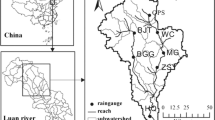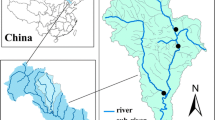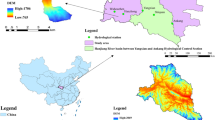Abstract
The assessment of peak flow rate, total runoff volume, and pollutant loads during rainfall process are very important for the watershed management and the ecological restoration of aquatic environment. Real-time measurements of rainfall-runoff and pollutant loads are always the most reliable approach but are difficult to carry out at all desired location in the watersheds considering the large consumption of material and financial resources. An integrated environmental modeling approach for the estimation of flash streamflow that combines the various hydrological and quality processes during rainstorms within the agricultural watersheds is essential to develop targeted management strategies for the endangered drinking water. This study applied the Hydrological Simulation Program—Fortran (HSPF) to simulate the spatial and temporal variation in hydrological processes and pollutant transport processes during rainstorm events in the Miyun Reservoir watershed, a drinking water resource area in Beijing. The model performance indicators ensured the acceptable applicability of the HSPF model to simulate flow and pollutant loads in the studied watershed and to establish a relationship between land use and the parameter values. The proportion of soil and land use was then identified as the influencing factors of the pollution intensities. The results indicated that the flush concentrations were much higher than those observed during normal flow periods and considerably exceeded the limits of Class III Environmental Quality Standards for Surface Water (GB3838-2002) for the secondary protection zones of the drinking water resource in China. Agricultural land and leached cinnamon soils were identified as the key sources of sediment, nutrients, and fecal coliforms. Precipitation volume was identified as a driving factor that determined the amount of runoff and pollutant loads during rainfall processes. These results are useful to improve the streamflow predictions, provide useful information for the identification of highly polluted areas, and aid the development of integrated watershed management system in the drinking water resource area.










Similar content being viewed by others
References
Ahmed SI, Singh A, Rudra R, Gharabaghi B (2014) Comparison of CANWET and HSPF for water budget and water quality modeling in rural Ontario. Water Qual Res J Can 49(1):53–71. 10.2166/wqrjc.2013.044
Akter A, Babel MS (2012) Hydrological modeling of the Mun River basin in Thailand. J Hydrol 452:232–246
Asadzadeh M, Leon L, Yang W, Bosch D (2016) One-day offset in daily hydrologic modeling: an exploration of the issue in automatic model calibration. J Hydrol 534:164–177. 10.1016/j.jhydrol.2015.12.056
Bicknell B, Imhoff J, Kittle J Jr, Jobes T, Donigian A Jr, Johanson R (2001) Hydrological simulation program-Fortran: HSPF version 12 user’s manual. AQUA TERRA Consultants, Mountain View, California
Cheng G, Dong C, Huang G, Baetz BW, Han J (2016) Discrete principal-monotonicity inference for hydro-system analysis under irregular nonlinearities, data uncertainties, and multivariate dependencies. Part I: methodology development. Hydrol Process 30:4255–4272
Cho JH, Lee JH (2015) Watershed model calibration framework developed using an influence coefficient algorithm and a genetic algorithm and analysis of pollutant discharge characteristics and load reduction in a TMDL planning area. J Environ Manag 163:2–10. 10.1016/j.jenvman.2015.07.049
Cho KH, Pachepsky YA, Kim M, Pyo J, Park M-H, Kim YM, Kim J-W, Kim JH (2016) Modeling seasonal variability of fecal coliform in natural surface waters using the modified SWAT. J Hydrol 535:377–385. 10.1016/j.jhydrol.2016.01.084
Diaz-Ramirez JN, McAnally WH, Martin JL (2012) Sensitivity of simulating hydrologic processes to gauge and radar rainfall data in subtropical coastal catchments. Water Resour Manag 26(12):3515–3538. 10.1007/s11269-012-0088-z
Doherty J (2016a) Model-independent parameter estimation user manual part I: PEST, SENSAN and global optimisers. Watermark Numerical Computing Brisbane, Australia
Doherty J (2016b) Model-independent parameter estimation user manual part II: PEST utility support software. Watermark Numerical Computing Brisbane, Australia 226
FAO (2016): World Reference Base for Soil Resources: http://www.fao.org/soils-portal/en/
Fonseca A, Ames DP, Yang P, Botelho C, Boaventura R, Vilar V (2014a) Watershed model parameter estimation and uncertainty in data-limited environments. Environ Model Softw 51:84–93. 10.1016/j.envsoft.2013.09.023
Fonseca A, Botelho C, Boaventura RAR, Vilar VJP (2014b) Integrated hydrological and water quality model for river management: a case study on Lena River. Sci Total Environ 485:474–489
Fraga I, Charters F, O'Sullivan A, Cochrane T (2016) A novel modelling framework to prioritize estimation of non-point source pollution parameters for quantifying pollutant origin and discharge in urban catchments. J Environ Manag 167:75–84. 10.1016/j.jenvman.2015.11.003
Gao W, Zhou F, Dong Y, Guo H, Peng J, Xu P, Zhao L (2014) PEST-based multi-objective automatic calibration of hydrologic parameters for HSPF model. Journal of Natural Resources 29:855–867
Gebremariam SY, Martin JF, DeMarchi C, Bosch NS, Confesor R, Ludsin SA (2014) A comprehensive approach to evaluating watershed models for predicting river flow regimes critical to downstream ecosystem services. Environ Model Softw 61:121–134. 10.1016/j.envsoft.2014.07.004
He M, Hogue TS (2012) Integrating hydrologic modeling and land use projections for evaluation of hydrologic response and regional water supply impacts in semi-arid environments. Environmental Earth Sciences 65(6):1671–1685. 10.1007/s12665-011-1144-3
Hsu SM, Wen HY, Chen NC, Hsu SY, Chi SY (2012) Using an integrated method to estimate watershed sediment yield during heavy rain period: a case study in Hualien County, Taiwan. Nat Hazards Earth Syst Sci 12(6):1949–1960. 10.5194/nhess-12-1949-2012
Huang G, Falconer RA, Lin B (2017) Integrated hydro-bacterial modelling for predicting bathing water quality. Estuar Coast Shelf Sci 188:145–155. 10.1016/j.ecss.2017.01.018
Huo SC, Lo SL, Chiu CH, Chiueh PT, Yang CS (2015) Assessing a fuzzy model and HSPF to supplement rainfall data for nonpoint source water quality in the Feitsui reservoir watershed. Environ Model Softw 72:110–116. 10.1016/j.envsoft.2015.07.002
Im SJ, Brannan KM, Mostaghimi S, Kim SM (2007) Comparison of HSPF and SWAT models performance for runoff and sediment yield prediction. Journal of Environmental Science and Health Part a—Toxic/Hazardous Substances & Environmental Engineering 42:1561–1570
Lal R (2003) Soil erosion and the global carbon budget. Environ Int 29(4):437–450. 10.1016/S0160-4120(02)00192-7
Lee S, Ni-Mesister W, Toll D, Nigro J, Gutierrez-Magness AL, Engman T (2010) Assessing the hydrologic performance of the EPA’s nonpoint source water quality assessment decision support tool using North American Land Data Assimilation System (NLDAS) products. J Hydrol 387(3-4):212–220. 10.1016/j.jhydrol.2010.04.009
Legates DR, McCabe GJ (1999) Evaluating the use of “goodness-of-fit” measures in hydrologic and hydroclimatic model validation. Water Resour Res 35(1):233–241. 10.1029/1998WR900018
Lehrter JC (2006) Effects of land use and land cover, stream discharge, and interannual climate on the magnitude and timing of nitrogen, phosphorus, and organic carbon concentrations in three coastal plain watersheds. Water Environment Research 78(12):2356–2368. 10.2175/106143006X102015
Li D, Liang J, Di Y, Gong H, Guo X (2015) The spatial-temporal variations of water quality in controlling points of the main rivers flowing into the Miyun Reservoir from 1991 to 2011. Environ Monit Assess 188:42
Liu J, Peng B, Xia Z, Sun J, Gao D, Dai W, Jiang P, Bai E (2017) Different fates of deposited NH4+ and NO3− in a temperate forest in northeast China: a 15N tracer study. Glob Chang Biol 23(6):2441–2449. 10.1111/gcb.13533
Luo C, Li Z, Xi Q, Pan J (2014) Sensitivity analysis of hydrological and water quality parameters of HSPF model. Journal of Agro-Environment Science 33:1995–2002
Luo C, Li Z, Wu M, Jiang K, Chen X, Li H (2017) Comprehensive study on parameter sensitivity for flow and nutrient modeling in the Hydrological Simulation Program Fortran model. Environ Sci Pollut Res:1–13
Mark Gallagher JD (2007) Parameter estimation and uncertainty analysis for a watershed model. Environ Model Softw 22(7):1000–1020. 10.1016/j.envsoft.2006.06.007
Massmann C, Wagener T, Holzmann H (2014) A new approach to visualizing time-varying sensitivity indices for environmental model diagnostics across evaluation time-scales. Environ Model Softw 51:190–194. 10.1016/j.envsoft.2013.09.033
Nash JE, Sutcliffe JV (1970) River flow forecasting through conceptual models part I—a discussion of principles. J Hydrol 10(3):282–290. 10.1016/0022-1694(70)90255-6
Pandey PK, Soupir ML, Haddad M, Rothwell JJ (2012) Assessing the impacts of watershed indexes and precipitation on spatial in-stream E. coli concentrations. Ecol Indic 23:641–652. 10.1016/j.ecolind.2012.05.023
Quan NH, Meon G (2015) Nutrient dynamics during flood events in tropical catchments: a case study in southern Vietnam. Clean-Soil Air Water 43(5):652–661. 10.1002/clen.201300264
Ribarova I, Ninov P, Cooper D (2008) Modeling nutrient pollution during a first flood event using HSPF software: Iskar River case study, Bulgaria. Ecol Model 211(1-2):241–246. 10.1016/j.ecolmodel.2007.09.022
Rong Q, Cai Y, Chen B, Shen Z, Yang Z, Yue W, Lin X (2017): Field management of a drinking water reservoir basin based on the investigation of multiple agricultural nonpoint source pollution indicators in north China. Ecological Indicators
Rosenberg EA, Keys PW, Booth DB, Hartley D, Burkey J, Steinemann AC, Lettenmaier DP (2010) Precipitation extremes and the impacts of climate change on stormwater infrastructure in Washington State. Clim Chang 102(1-2):319–349. 10.1007/s10584-010-9847-0
Seong C, Her Y, Benham BL (2015) Automatic calibration tool for Hydrologic Simulation Program-FORTRAN using a shuffled complex evolution algorithm. Water 7(2):503–527. 10.3390/w7020503
Shen Z, Qiu J, Hong Q, Chen L (2014) Simulation of spatial and temporal distributions of non-point source pollution load in the Three Gorges Reservoir region. Sci Total Environ 493:138–146. 10.1016/j.scitotenv.2014.05.109
Sobel RS, Rifai HS, Petersen CM (2017) Integration of tidal prism model and HSPF for simulating indicator bacteria in coastal watersheds. Estuarine, Coastal and Shelf Science
Sutton S (2010) The most probable number method and its uses in enumeration, qualification, and validation. Journal of Validation Technology 16:35
Tsai ZX, You GJY, Lee HY, Chiu YJ (2013) Modeling the sediment yield from landslides in the Shihmen Reservoir watershed, Taiwan. Earth Surf Process Landf 38(7):661–674. 10.1002/esp.3309
USEPA (2015): BASINS 4.1 (Better Assessment Science Integrating point & Non-point Sources) modeling framework. National Exposure Research Laboratory RTP, North Carolina, http://www.epa.gov/exposure-assessment-models/basins
Walton RS, Hunter HM (2009) Isolating the water quality responses of multiple land uses from stream monitoring data through model calibration. J Hydrol 378(1-2):29–45. 10.1016/j.jhydrol.2009.09.004
Wang G, Chen L, Huang Q, Xiao Y, Shen Z (2016) The influence of watershed subdivision level on model assessment and identification of non-point source priority management areas. Ecol Eng 87:110–119. 10.1016/j.ecoleng.2015.11.041
Wu J, SL Y, Zou R (2006) A water quality-based approach for watershed wide BMP strategies. J Am Water Resour Assoc 42(5):1193–1204. 10.1111/j.1752-1688.2006.tb05606.x
Xie H, Shen Z, Chen L, Qiu J, Dong J (2017) Time-varying sensitivity analysis of hydrologic and sediment parameters at multiple timescales: implications for conservation practices. Sci Total Environ 598:353–364. 10.1016/j.scitotenv.2017.04.074
Yan C-A, Zhang W, Zhang Z (2014): Hydrological modeling of the Jiaoyi watershed (China) using HSPF model. Scientific World Journal
Yazdi J, Moridi A (2017) Interactive reservoir-watershed modeling framework for integrated water quality management. Water Resour Manag 31(7):2105–2125. 10.1007/s11269-017-1627-4
Young R, Onstad C, Bosch D, Anderson W (1989) AGNPS: a nonpoint-source pollution model for evaluating agricultural watersheds. J Soil Water Conserv 44:168–173
Zhang J, Ross M (2012) Hydrologic simulation of clay-settling areas in the phosphate mining district, Florida. Hydrol Process 26(24):3770–3778. 10.1002/hyp.9439
Zheng H, Li Y, Robinson BE, Liu G, Ma D, Wang F, Lu F, Ouyang Z, Daily GC (2016) Using ecosystem service trade-offs to inform water conservation policies and management practices. Front Ecol Environ 14(10):527–532. 10.1002/fee.1432
Zuo D, Xu Z, Yao W, Jin S, Xiao P, Ran D (2016) Assessing the effects of changes in land use and climate on runoff and sediment yields from a watershed in the Loess Plateau of China. Sci Total Environ 544:238–250. 10.1016/j.scitotenv.2015.11.060
Funding
Financial support for this study was provided by the National Natural Science Foundation of China (No. 51579011) and the fund for Innovative Research Group of the National Natural Science Foundation of China (No. 51421065).
Author information
Authors and Affiliations
Corresponding author
Additional information
Responsible editor: Philippe Garrigues
Electronic supplementary material
ESM 1
(DOCX 286 kb)
Rights and permissions
About this article
Cite this article
Qiu, J., Shen, Z., Wei, G. et al. A systematic assessment of watershed-scale nonpoint source pollution during rainfall-runoff events in the Miyun Reservoir watershed. Environ Sci Pollut Res 25, 6514–6531 (2018). https://doi.org/10.1007/s11356-017-0946-6
Received:
Accepted:
Published:
Issue Date:
DOI: https://doi.org/10.1007/s11356-017-0946-6




